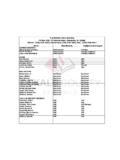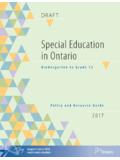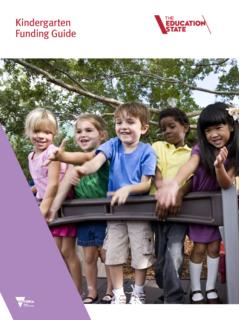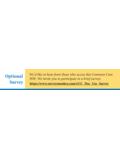Transcription of Science K Unit 1 WEATHER SCIENCE …
1 SCIENCE K unit 1 WEATHER . SCIENCE . KINDERGARTEN. unit ONE. WEATHER . SCIENCE K unit 1 WEATHER . STANDARDS AND INDICATORS: A7, A8. WEATHER -Describe and record daily WEATHER conditions throughout the year. (Try incorporating into Saxon meeting time). CONCEPTS: 1. WEATHER changes day to day. 2. WEATHER includes many features including: Cloud cover Precipitation Wind Temperature 3. Tools used for measuring WEATHER . Wind scale (sock). Thermometers Rain gauges 4. WEATHER can be predicted by patterns. 5. WEATHER affects decision we make about clothing and activities. SKILLS: Be able to do: 1. Record-(pictures/words). Graph-(pictograph/bar/line). Observe-(use senses). Use senses 2. Understand and use proper vocabulary (try substituting SCIENCE books during comprehension/vocabulary time and use pre-set objectives). Cloud cover (types). Precipitation (rain, snow, sleet, hail). Wind Temperature (hot/cold).
2 3. Measure using: wind indicator, thermometer, rain gauge. 4. Record/read and interpret daily/weekly WEATHER patterns to predict future WEATHER . 5. Interpret WEATHER patterns to determine appropriate clothing and activity choices. (Using senses). MATERIALS. WEATHER STC kits Graphs Thermometer Websites-weatherbug, etc. Wind indicators-flag, sock SUGGESTED BIG IDEAS/ESSENTIAL QUESTIONS: 1. What is WEATHER ? (Cold/hot, humid/dry, windy, cloudy, percipatation). 2. What tools do we use to measure WEATHER and how do we use the tools? 3. How does WEATHER influence our clothing choices? How does WEATHER influence our activity choices? 4. What makes a WEATHER pattern? SCIENCE K unit 1 WEATHER . SCIENCE CONTENT STANDARD CMT EXPECTED. CONCEPTUAL GRADE-LEVEL CONCEPT: Daily and seasonal WEATHER PERFORMANCES. THEME: conditions affect what we do, what we wear and how we feel. Energy in the Earth's GRADE-LEVEL EXPECTATIONS: A7.
3 Systems - How do 1. The sun is the source of heat and light that warms the land, external and internal Describe and record daily air and water. Variations in the amount of sunlight that sources of energy WEATHER conditions. reaches the earth cause the WEATHER . affect the Earth's A8. systems? 2. WEATHER conditions can be observed and described as sunny, cloudy, rainy, foggy, snowy, stormy, windy, hot or cold. Relate seasonal WEATHER WEATHER observations can be made based on how we feel, patterns to appropriate what we see or hear, or by using WEATHER measurement choices of clothing and CONTENT instruments such as thermometers. activities. STANDARD: 3. Changes in WEATHER conditions can be recorded during different times of day, from day to day, and over longer WEATHER periods of time (seasonal cycle). Repeated observations can conditions vary daily and seasonally. show patterns that can be used to predict general WEATHER conditions.
4 For example, temperatures are generally cooler at night than during the day and colder in winter than in spring, summer or fall. 4. WEATHER influences how we dress, how we feel, and what we do outside. 5. WEATHER affects the land, animals and plants, and bodies of water. 6. When the temperature is below freezing, water outside freezes to ice and precipitation falls as snow or ice; when the temperature is above freezing, ice and snow melt and precipitation falls as rain. 7. Clouds and fog are made of tiny drops of water. Clouds have different shapes, sizes and colors that can be observed and compared. Some cloud types are associated with precipitation and some with fair WEATHER . 8. Wind is moving air. Sometimes air moves fast and sometimes it hardly moves at all. Wind speed can be estimated by observing the things that it moves, such as flags, tree branches or sailboats. KEY SCIENCE VOCABULARY: WEATHER , season (winter, spring, summer, fall), thermometer, precipitation, freezing, melt SCIENCE K unit 1 WEATHER .
5 LESSONS. A useful structure for inquiry-based learning units follows a LEARNING CYCLE model. One such model, the 5-E Model , engages students in experiences that allow them to observe, question and make tentative explanations before formal instruction and terminology is introduced. Generally, there are five stages in an inquiry learning unit : Engagement: stimulate students' interest, curiosity and preconceptions;. Exploration: first-hand experiences with concepts without direct instruction;. Explanation: students' explanations followed by introduction of formal terms and clarifications;. Elaboration: applying knowledge to solve a problem. Students frequently develop and complete their own well-designed investigations;. Evaluation: students and teachers reflect on change in conceptual understanding and identify ideas still under development . SCIENCE K unit 1 WEATHER . WEATHER :(K).
6 Lesson 1: Sharing What We Know about WEATHER Pre- unit assessment Goal: Students will share what they know about WEATHER through discussion about today's WEATHER and about how they decide what to wear to school. (Discussion will be repeated after unit ). Objectives: o Students observe and describe today's WEATHER . o Students discuss how they decide what to wear to school each day. o Students organize information about their favorite types of WEATHER on a class graph. Lesson 2: Observing the WEATHER Goal: Students will use their senses (sight, hearing, smell, and touch) to find out about the WEATHER . Objectives: o Students will use their senses to observe the WEATHER . o Students discuss and record data about observable WEATHER features. o Students brainstorm questions they have about WEATHER . o Students read about and discuss how meteorologists study WEATHER . Lesson 3: Recording the WEATHER Goal: Students will begin observing and describing the WEATHER in the first two lesson, focusing on cloud cover and precipitation.
7 Recording observations on a daily WEATHER calendar introduces student to long-term data collection. At the end of the unit , students will summarize the WEATHER data they have collected. Objectives: o Students observe and discuss cloud cover and precipitation. o Students collect data about cloud cover and precipitation. o Students record WEATHER data on a calendar. Lesson 4: Estimating Wind Speed Goal: Students will make a wind flag and then learn to use a simple wind scale. The students will add wind data to their daily WEATHER calendar helping them to acquire a more complete picture of the daily WEATHER . Objectives: Students describe how they know when the wind is blowing. Students observe and describe a flag moving in the wind. Students discuss and record the speed of the wind. Students apply a wind scale to the movement of the flag. Lesson 5: Reading a Thermometer *Lesson 1 of 3.
8 Goal: Students will explore temperature and be introduced to a thermometer a tool for measuring temperature. Students will use a really thermometer to discover how a thermometer reacts to temperature and a model thermometer to learn to read the scale. As they practice reading this scale, they begin to see that the higher numbers on the scale correspond with hotter temperatures and the lower numbers correspond with colder temperature. Objectives: o Students observe and discuss thermometers as tools that measure temperature. o Students read the numbers on the thermometer scale. SCIENCE K unit 1 WEATHER . o Students relate the numbers on the scale to hotter or colder temperatures. o Students observe and record cloud cover, precipitation, and wind on the WEATHER Calendar. Lesson 6: Making a Model Thermometer *Lesson 2 of 3. Goal: Students will continue to explore temperature by making their own thermometer.
9 The students will work on reading the thermometer scale and relating the numbers on the scale to hotter or colder temperatures. Students will practice adjusting their thermometers to match temperatures. Objectives: o Students read temperatures on model thermometers. o Students read and record the temperature shown on an illustration of a thermometer. o Students relate a specific temperature to appropriate activities and clothing. o Students observe, discuss, and record today's WEATHER on the WEATHER Calendar. Lesson 7: Comparing Inside and Outside Temperatures *Lesson 3 of 3. Goal: Students will continue their exploration of temperature and thermometer by recording and comparing actual temperature in the classroom and outside. A classroom discussion helps students recognize that it is the outside temperature that gives them information about the WEATHER . Students begin to use their second long-term data collection tool, the Temperature Graph, to record the daily temperature.
10 They will continue recording temperature on the graph throughout the rest of the unit . Objectives: o Students read the scale on a real thermometer. o Students measure, record, and compare the temperatures in the classroom and outside. o The class compiles temperature data on a graph. o Students continue to collect WEATHER data and record it on the WEATHER Calendar. Lesson 8: Embedded assessment of student's growth in learning to read and record temperature. Introduction of thermometer as measurement tool for temperature. Goal: Students will be introduced to thermometers as a measurement tool for temperature using real and model thermometers. Objectives: o Students measure the temperatures of hot and cold water. o Students conduct an experiment and discuss the results. o Students record their data on a graph. o Lesson 9: Experimenting with Color and temperature Goal: Students will apply knowledge of thermometer reading to experiment with the effects colors can have on thermometer readings.









